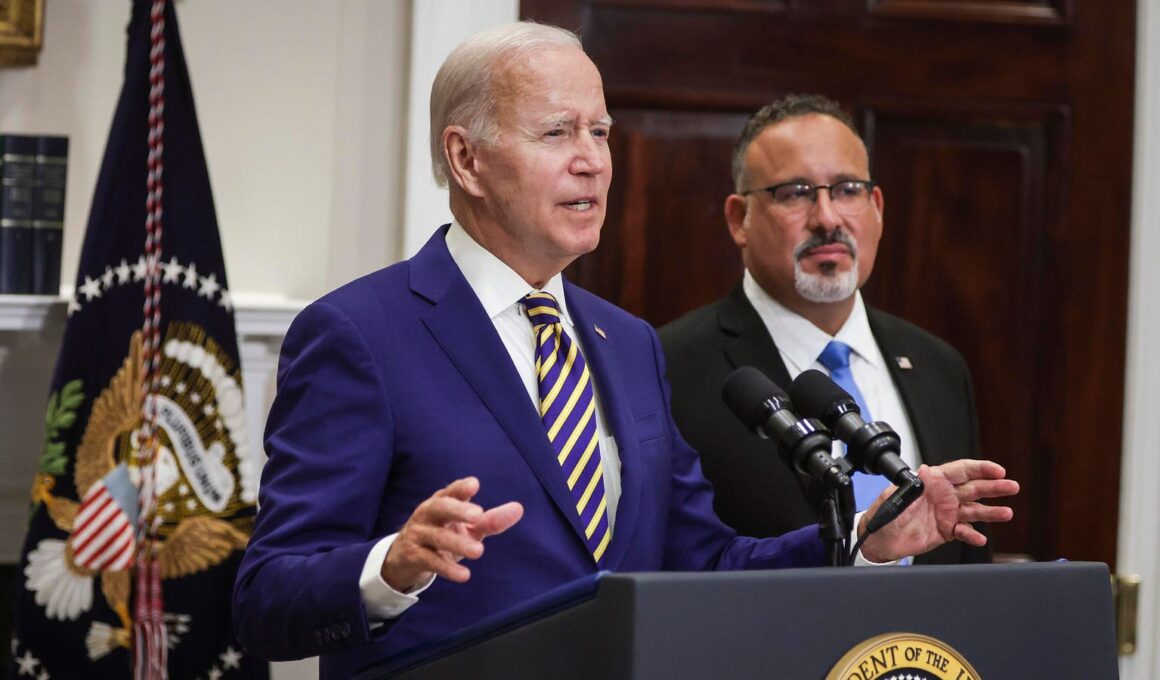Topline
Some federal student loan borrowers’ payments are now on pause while a court battle plays out over the Biden administration’s latest student loan forgiveness plan, with a recent court ruling pausing all forgiveness entirely—and the Supreme Court is now considering two different lawsuits over the program’s fate.
President Joe Biden, joined by Education Secretary Miguel Cardona, speaks on student loan debt at … [+]
Key Facts
Republicans sued the Biden administration over its Saving on a Valuable Education (SAVE) plan, an income-driven repayment plan that lowers the percentage of their monthly income that borrowers pay, allows borrowers’ debt to be forgiven sooner, and makes it possible for more borrowers to pay $0 per month.
The SAVE plan sparked two separate but similar lawsuits from GOP-led states, one filed in Kansas by attorneys general in multiple states (Alaska v. Department of Education) and the other filed in Missouri (Missouri v. Department of Education), arguing the sweeping relief it provides is “unlawful” and imposes a financial burden on states.
Alaska v. Department of Education: A district court blocked part of the SAVE plan from taking effect, but the 10th Circuit Court of Appeals then opposed that ruling and said the plan could take effect while the court battle continues—prompting GOP-led states to take the case to the Supreme Court, asking the court to pause parts of the program while the litigation plays out.
Missouri v. Department of Education: A district court similarly paused only one part of the SAVE plan, but the 8th Circuit Court of Appeals then blocked the program entirely, ruling Friday the government can’t provide any relief through the SAVE plan until the 8th Circuit or the Supreme Court rules otherwise—which led the Biden administration to ask the Supreme Court Tuesday to throw out the 8th Circuit’s decision.
Texas—one of the states involved with the Kansas lawsuit—filed a letter at the Supreme Court on Saturday, noting that the 8th Circuit’s ruling pausing the SAVE program entirely makes their previous request irrelevant, but they now want the Supreme Court to either order the Missouri district court to throw out the SAVE plan entirely, or accept the case for oral arguments, which means the high court would decide whether or not it’s lawful.
The Biden administration’s request to the Supreme Court in the Missouri case asks the high court to throw out the 8th Circuit’s ruling and let the SAVE plan take effect while litigation plays out, or take up the case for oral arguments, and it remains to be seen how the Supreme Court will navigate the two separate legal disputes.
Get Forbes Breaking News Text Alerts: We’re launching text message alerts so you’ll always know the biggest stories shaping the day’s headlines. Text “Alerts” to (201) 335-0739 or sign up here.
What Does This Mean For Borrowers?
The Department of Education said Monday borrowers in the program will have their loans put in forbearance—meaning they’ll be on pause and borrowers won’t have to pay—while the court dispute plays out. Borrowers whose loans are paused won’t accrue interest while they’re in forbearance, according to the Education Department. Any time spent in forbearance also won’t count toward loan forgiveness on income-driven repayment plans or for public servants. SAVE plan borrowers who have already received a bill for August are still being put in forbearance, which means paying it isn’t required, the agency noted, and borrowers who haven’t yet received a bill for August won’t receive one. The Education Department said it will provide “regular updates” to borrowers on the court dispute.
What Is The Save Plan?
The Biden administration first announced the SAVE plan in August 2023, replacing the previous Revised Pay-As-You-Earn (REPAYE) plan. While previous plans allowed borrowers’ debt to be forgiven after 20 or 25 years of making payments, the SAVE plan cut that down to 10 years for anyone who owed $12,000 or less, with one year added per $1,000 owed (up to a maximum of 20 or 25 years, depending on the kind of loan). It also reduced undergraduate loan payments to 5% of a borrower’s monthly income, down from 10%; reduced accrued interest on payments and raised the salary minimum for when a borrower has to make monthly payments. Under the new plan, anyone whose income is less than 225% of the poverty line qualified for $0 monthly payments, versus 150% previously. The White House justified the changes under federal rules that say income-driven repayment plans “shall require payments that vary in relation to the appropriate portion of the annual income of the borrower … as determined by the [Education] Secretary.”
What To Watch For
Borrowers’ loans will remain in forbearance for now while the court battles play out. It’s unclear when the Supreme Court could rule on either of the requests from Texas and the Biden administration. If it takes up the dispute over the SAVE plan, the cases would be heard during the court’s next term, which begins in October, and the court would release its opinion sometime before the term ends in June 2025.
What We Don’t Know
How far the 8th Circuit’s ruling goes when it comes to student loan forgiveness. The ruling blocking the SAVE plan broadly bars the government from providing “any further forgiveness of principal or interest” for loans covered by income-driven repayment rules or the Federal Family Education Loan (FFEL) program. The Biden administration asked the 8th Circuit Tuesday to clarify what exactly that means in practice, since it could affect student loan programs outside of the SAVE plan that aren’t at issue in the lawsuit. The government asked the court to respond to its request by Friday.
Chief Critic
The 8th Circuit’s Friday ruling blocking the SAVE plan “rejects a practice of providing loan forgiveness that goes back 30 years,” Education Secretary Miguel Cardona said in a statement Monday. “It’s shameful that politically motivated lawsuits waged by Republican elected officials are once again standing in the way of lower payments for millions of borrowers.”
Big Number
More than 8 million. That’s the number of federal student loan borrowers who were already enrolled in the SAVE plan as of July, according to the Biden administration. It noted that any uncertainty over the plan is also likely to affect other borrowers with income-driven repayment plans, however—and that surges in borrowers asking for clarification about their student loan plans has often led to student loan servicers suffering widespread “breakdowns” that affect all borrowers.
Tangent
The SAVE program is separate from a different student loan forgiveness plan the Biden administration announced in April, which would affect borrowers who now owe more than they started with, borrowers who have been paying undergraduate loans for more than 20 years and those who are eligible for existing forgiveness programs but never applied for them. The Biden administration said it would start sending out emails to borrowers in July about that plan, but it still has to be finalized, and it’s unclear what the final version will look like. It also remains unclear how that could be affected by the ongoing court dispute over the SAVE plan, since the 8th Circuit’s Friday ruling broadly blocks the government from providing “any further forgiveness of principal or interest” for loans covered by income-driven repayment rules or the Federal Family Education Loan (FFEL) program.
Key Background
The Biden administration has put a strong emphasis on student loan forgiveness, responding to widespread calls on the left for debt relief — even as President Joe Biden hasn’t gone as far as other Democrats who want full loan forgiveness. Biden initially announced widespread loan forgiveness that would forgive up to $20,000 in loans for all federal borrowers making up to $125,000 per year, but Republicans opposed the plan in court. The Supreme Court ultimately struck the plan down in June 2023, ruling the Biden administration had exceeded its authority in implementing the forgiveness program. The Biden administration has opted for more piecemeal approaches to loan forgiveness since then in response, providing more than $168 million in relief as a result, the Education Department reported in July.
Further Reading







